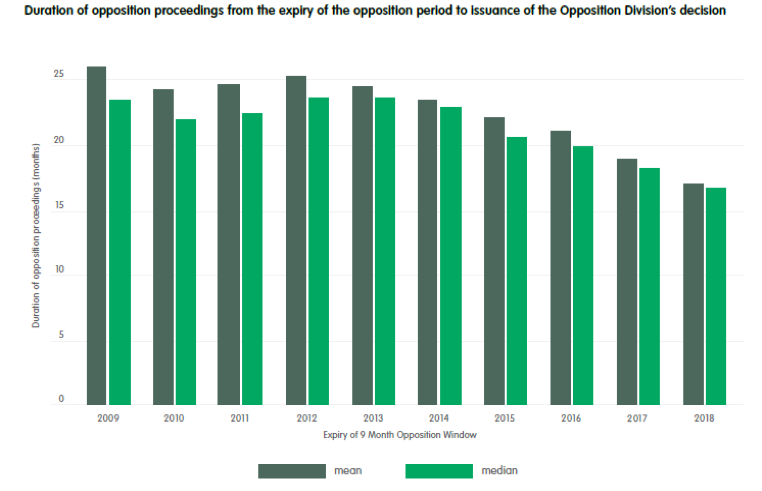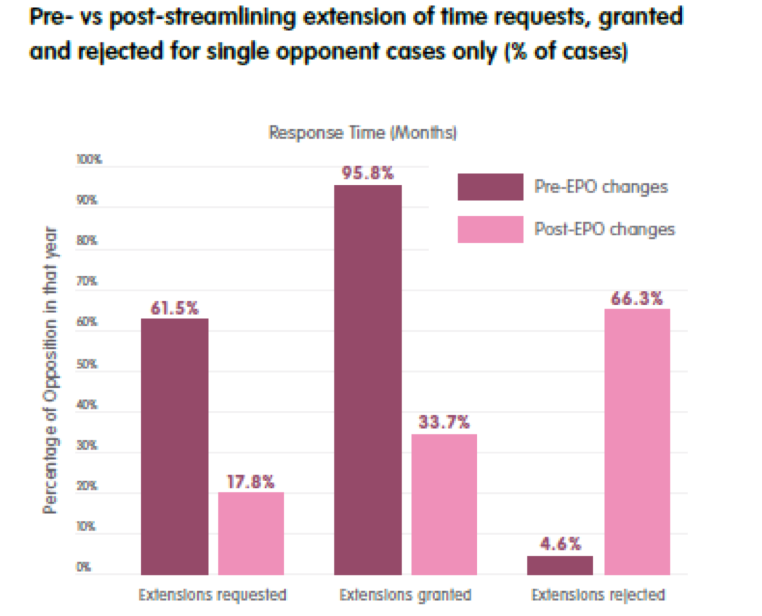“While the acceleration of opposition proceedings may provide ‘early certainty,’ the compressed timeline undoubtedly places greater time pressure on patentees to prepare their defense.”

In early 2019, we undertook a comprehensive research project to develop a forensic understanding of European Patent Office (EPO) oppositions, particularly in the life sciences sector, analyzing EPO opposition data in far greater depth than in any publicly available report.
We examined more than 5,000 opposition cases filed at the EPO over the last 10 years and studied the timelines for hundreds of life sciences oppositions. The resulting report, entitled EPO Opposition Trends in the Life Sciences Sector, offers a granular understanding of the EPO opposition procedure and its various nuances.
EPO Streamlining is on Track
We were particularly curious about the effects of the EPO’s streamlining initiative on the opposition procedure. How well was it working? How long do most opposition proceedings now take? Which stages of the opposition procedure have been affected the most?
Introduced in July 2016, the EPO’s streamlining initiative was designed to simplify opposition proceedings and deliver decisions more quickly, thus providing “early certainty”. The EPO’s target pendency is 15 months by 2020 (opposition pendency here being measured from expiry of the nine-months-from-grant period for filing an opposition to the Opposition Division issuing its decision).
Our research revealed that the streamlining initiative is on track to meet its target in the life sciences sector. The mean opposition pendency has been reduced from just over 22 months in 2015 (pre-streamlining) to 17 months in 2018 (post-streamlining), as shown in Figure 1.
Figure 1

Importantly, we found that each stage of the opposition procedure is speeding up. For example, the EPO now usually issues an invitation to the patentee to file its response to the opposition(s) within just a few weeks of the opposition period expiring (setting a four-month deadline for response) and issues its summons to oral proceedings about three months after the response has been filed.
Response Time
Perhaps the most significant effect of the streamlining initiative has been on the time given to patentees for responding to oppositions. In the streamlined procedure the patentee no longer has the right to extend the four-month deadline for responding to an opposition. We took a snapshot of cases within a six-month window straddling the introduction of the streamlining initiative in mid-2016 and saw stark differences in the time being taken for patentees to respond to oppositions.
Before the introduction of the streamlining initiative, the majority of patentees (68%) took a two-month extension of time and filed their response within 4-6 months of the EPO’s invitation. A significant proportion of those (12%) secured a further extension of time and took more than six months to respond. By contrast, after introduction of the streamlining initiative only a small proportion of patentees (15%) took a two-month extension of time, and patentees very rarely took longer than six months to respond (just under 2%).
A more drastic effect appeared when we focussed on opposition cases involving a single opponent. Whereas before streamlining more than two-thirds (69%) of patentees filed their response within 4-6 months of the EPO’s invitation, and 9% later than that, following the introduction of streamlining, a mere 8% of responses were filed within 4-6 months, and 0.6% later than that.
Is the EPO Getting Stricter?
We wanted to find out what was driving this sharp reduction in patentee response times. Had the EPO become stricter about granting requests for extensions of time? Or were patentees simply less likely to ask for an extension in the first place?
The answer is both. We found very significant changes in behavior for both the EPO and patentees when it comes to the requesting and granting of extensions of time in opposition. Not only is the EPO now much less likely to allow a patentee’s request for an extension of time, especially for single opponent cases, but patentees are also much less likely to request an extension of time in the first place.
Following introduction of the streamlining initiative, only 34% of requests for a two-month extension of time were granted in single opponent cases. In comparison, 96% of requests were granted before streamlining, as shown in Figure 2.
Figure 2

Also shown in Figure 2, fewer patentees are seeking an extension of time for responding to an opposition, with extensions now being requested in only 18% of single opponent cases. Previously, extensions of time were requested in 62% of such cases—a striking example of an EPO initiative changing patentee behavior.
Getting Ready to Act Fast
While the acceleration of opposition proceedings may provide “early certainty,” the compressed timeline undoubtedly places greater time pressure on patentees to prepare their defense.
There is now significantly less time for patentees to generate additional experimental data or to provide expert declarations to defend their patents in in opposition, whereas the amount of time afforded to opponents to prepare their attack has not changed (nine months from grant, and possibly much longer in practice if the case is being monitored before grant). This shift means that it is now even more important for patentees to take early pre-emptive action.
Multi-Party Oppositions
Our research also focused on several other aspects of the EPO opposition procedure, including the prevalence of multi-party oppositions. Despite there being no limit on the number of oppositions that can be filed against any one patent, our research illustrated that the distribution of opponent numbers is very heavily skewed towards just one or two opponents.
In the sample of life science patents we analyzed, 670 oppositions were filed in 2018. Approximately three quarters of these involved only one opponent (76%, 512 patents), whereas only a dozen oppositions involved seven or more opponents. Our analysis highlighted that cases in which there are three or more opponents are extremely rare.
New Approaches Required
Achieving success in oppositions and appeals at the EPO is critical for any innovation-oriented business seeking commercial advantage and growth. The insights generated from our research come at an important juncture in the EPO’s drive to reengineer its opposition and appeals procedures. The procedural changes introduced by the EPO in 2016 to streamline the opposition process have demonstrably begun to take effect, producing tightened timeframes that, while welcome, require new strategies and early action by patent proprietors.
Image Source: https://www.flickr.com/photos/european_patent_office/7448348854/in/album-72157630299220950/

![[IPWatchdog Logo]](https://ipwatchdog.com/wp-content/themes/IPWatchdog%20-%202023/assets/images/temp/logo-small@2x.png)


![[Advertisement]](https://ipwatchdog.com/wp-content/uploads/2024/04/Patent-Litigation-Masters-2024-sidebar-early-bird-ends-Apr-21-last-chance-700x500-1.jpg)

![[Advertisement]](https://ipwatchdog.com/wp-content/uploads/2021/12/WEBINAR-336-x-280-px.png)
![[Advertisement]](https://ipwatchdog.com/wp-content/uploads/2021/12/2021-Patent-Practice-on-Demand-recorded-Feb-2021-336-x-280.jpg)
![[Advertisement]](https://ipwatchdog.com/wp-content/uploads/2021/12/Ad-4-The-Invent-Patent-System™.png)







Join the Discussion
2 comments so far.
Mark Summerfield
December 6, 2019 06:44 amI have a question about your Figure 1.
Since this data necessarily only includes cases in which the opposition division has actually issued a decision, isn’t it to be expected that the mean and median will be lower for more recent years? Cases that are taking longer to reach a conclusion are still pending, and therefore do not contribute to the results. So when decisions eventually issue, and the final durations are known, this will pull up the mean and median to something (presumably) closer to the earlier years.
It seems to me that this data would be more meaningful if it also included the number of concluded oppositions counted in each year, along with the number still pending.
Our am I missing something about the way you have conducted the analysis?
MaxDrei
December 5, 2019 11:13 amPraise to the Mewburn firm for doing the heavy number crunching and analysis.
Any definition of “quality” should require that the tribunal gets expeditiously to a decision that is robust enough to render an appeal pointless. Any organisation can issue quick decisions, if appeal-proofness is not a factor. At first instance then, speed alone is not enough.
The English courts have been delivering that degree of “quality” for many years. Only one third of losers at first instance even begin to launch an appeal process. Compare that with the EPO, where most every loser appeals, believing they can prevail before the Technical Board of Appeal. One hopes that the EPO, with these reforms, will get there too but, frankly, one has very little expectation of it.
But then we have to factor in the cost to the parties, of going through such disputed proceedings. England is where the Rolls-Royce machine was invented and English law is still seen as the R-R of disputed proceedings. The thing about a Roller is that, if you need to ask how much it costs, it is not for you. In general, the more “front-loaded” the proceedings are, the more costly. The point about these EPO reforms is though, for the parties in dispute, they are also going to keep the cost down, aren’t they?